Executive Summary
This document is a marketing plan for Dyson Company to sell home appliances in New York State. The proposal is part of a larger marketing plan to expand the company’s North American business, given that its operations are mostly domiciled in the United Kingdom (UK) and Europe. Dyson’s value proposition is based on its innovative and technological capabilities.
The convenience and high-quality attributes associated with the company’s products are also supplementary value streams that are expected to improve its overall market success. An approach will be developed to reach the target customer group, which is comprised of middle-income earners in New York.
In this plan, Dyson will position itself as a premium brand home appliance business with products that have extensive functional features unlike any other in the business. Supplementary elements of the marketing plan that will be highlighted in this report include a discussion on projected sales revenue, analysis of the competitive environment, and implementation control mechanisms.
Situation Analysis
Founded in 1993, Dyson Company has grown from a small business specializing in the production and distribution of vacuums to a global enterprise with a growing market presence in other product areas, including hairdryers, desk fans, air purifiers, and LED lights. The company’s products have mostly been developed through internal research and development competencies with little input from outside parties (Tani, 2017).
This in-house strategy has also permeated its marketing strategy, where little attention has been paid to conventional promotion strategies, like magazines and television, and the focus directed towards word-of-mouth communication. The in-house product promotion strategy has allowed the company to nurture an extraordinary work ethic among its employees, which has been premised on dedication, commitment, and a culture of excellence.
Dyson’s business philosophy traces its roots to the work ethic demonstrated by the company’s founder, James Dyson, who focused more on creating superior brands as opposed to advertising. Therefore, for many years, the company has relied on developing disruptive products by setting a new level of product design that competitors have to match.
Therefore, Dyson’s employees consider themselves market-leaders and pioneers in their different fields of engagement (Tani, 2017). Nonetheless, recent market developments have forced the company to seek newer ways of cementing its dominant position in the home appliance business by having a strong brand presence internationally. This vision necessitates the current marketing plan aimed at expanding the fledgling business to the US market.
Value Proposition
Dyson promises to offer its customers high-quality products and excellent after-sales services via its brick-and-mortar and online business models. Particularly, the firm’s cordless vacuum cleaner is expected to provide its clients with a convenient way of cleaning their houses, devoid of the limitations of movement associated with the conventional vacuum cleaner.
The company intends to use the most advanced battery technology to achieve this goal, thereby giving its customers long hours of service without additional time lost or offset due to the lack of a cordless power source. Overall, the list below outlines key value propositions for the company’s home appliance business.
- A sleek product design that is aesthetically pleasing due to the cordless feature of the vacuum cleaners, which offers better utility advantages to customers
- The convenience of having a cordless vacuum that can be safely used in remote locations without any utility value lost due to the lack of a corded power source. Additionally, the cordless and bagless vacuum cleaners will allow users to access hard-to-reach places. Its lightweight feature also adds to its mobility and the lack of an outlet sets it apart from the competition
- High-quality products because the vacuums are long-lasting and durable compared to substitute brands. The technology used to develop these features include a powerful vacuum suction and adequate battery time that rivals, if not better than, the conventional power source
SWOT Analysis
The following SWOT analysis aims to identify key strengths, weaknesses, opportunities, and threats associated with Dyson’s operations and that could be impactful to the current marketing plan.
Table 1. SWOT Analysis
Market Analysis
Competition
Innovation is the key element driving Dyson’s competitive advantage in the home appliance industry in the United Kingdom (UK) and around the world. However, competition in the sector still exists and it is described in various forms below.
- The first type of competition that Dyson Company faces is from other companies that also produce innovative home-appliance products. For example, Techtronic Floor Care Technology Limited, Irobot Corp, and Electrolux AB are three major competitors that have adopted the company’s business model of innovation in developing their products, thereby posing significant competition in this regard (Craft Company, 2021)
- Internationally established brands, such as Samsung, Bosch, and Whirlpool define the second group of competitors for Dyson Company. Some of these corporations have been in the home appliance business for a longer time than Dyson and not only engage in the production but also the distribution of electronic goods (Craft Company, 2021). Consequently, they enjoy immense advantages in leveraging their international market expertise to outwit their rivals and to the detriment of upcoming businesses. Figure 1 below highlights the gap in market share that Samsung, one of these established brands, has over conventional home appliance companies, such as Bosch.
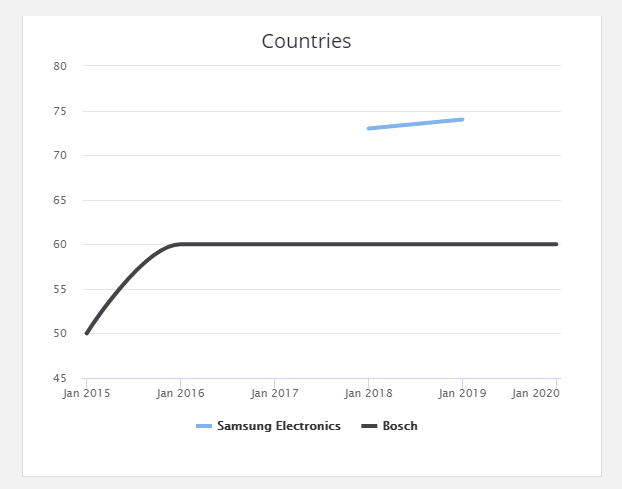
- Dyson company also faces competition from venture capitalist firms which engage produce alternative home appliance products through contract electronic manufacturing
Products and Services
Innovation: Dyson is known as one of the most innovative companies in the home appliance business through its disruptive products, including vacuum cleaners, hand dryers, desk fans, air purifiers, and LED lights. Therefore, the uniqueness of these products is attributed to their innovative feature because they reflect this key area of competency. For example, the bagless vacuum cleaner is one of the most distinguishable innovative products that has come from the company. This means that Dyson’s focus on innovation is the key driving force that has made it popular among its target market.
Market Research: In line with its innovation strategy, Dyson Company also engages in extensive market research on key fundamental areas of operation, such as research and development. In other words, it collaborates with other players in this field, including universities, industry leaders, and companies in linked sectors. For example, in 2014, Dyson collaborated with the Imperial College of London to develop better models of robotic vacuum cleaners – a process that led to the enhancement of its product design and functionality features (Dyson College of Design, 2021).
Keys to Success
Focus on Innovation: As highlighted in this document, Dyson Company has differentiated itself from the competition by developing innovative products in the home appliance market. This attribute has largely been responsible for the firm’s current market success.
Premium Branding: By presenting itself as a premium brand to its core customers, Dyson has been able to sustain a premium pricing plan, which is responsible for its profitability over the years.
Network of Partnerships: Dyson Company enjoys a vast network of partnerships with companies and institutions within and outside the home appliance market. These ventures have improved their research and development capabilities and aided in market expansion.
Critical Issues
The most critical issue affecting the operations of Dyson Company is strict regulations that hinder the company’s performance by enabling competitors to have an unfair advantage through brand positioning. For example, prevailing European Union (EU) regulations that are responsible for regulating the energy efficiency of vacuum cleaners have caused legal issues between Dyson and some of its rivals.
For example, in 2018, the firm sued Bosch and Siemens for misleading its customers about the energy efficiency and performance ratings of their machines due to faulty EU regulations (General Court of the European Union, 2018). Dyson believes that regulatory loopholes have made it possible for rivals to brand their machines as better performing than their rivals do, while the opposite may be true. Therefore, the lack of a streamlined regulatory framework to govern operations in the sector is one of the major critical issues affecting Dyson Company.
Historical Results
Within a short time after establishment, the Dyson Company has grown from a small business enterprise to one of the largest corporations in the United Kingdom. Today, it controls more than 50% of the UK vacuum market (Craft Company, 2021). Moreover, it is estimated that the Dyson Company outsells its rivals about five times more than its closest rival does (Craft Company, 2021). These statistics suggest that the firm has had a positive financial performance throughout the years.
Macro environment
The macro-environment of the Dyson Company affects different aspects of its operational performance, including profitability, product design, and market reception. Three issues characterize the microenvironment and affect these aspects of operational performance. First, technological development has influenced various aspects of operational performance, including product designs, pricing, and distribution services.
Secondly, uncertainties in the global market due to the COVID-19 pandemic, which has caused disruptions in global supply chain management, have also affected the company’s bottom-line performance (Safa, Sharma, & Zelbst, 2021; Sinha, Bagodi, & Dey, 2020). Thirdly, geopolitical issues and economic concerns surrounding “Brexit” and the ensuing policy concerns on engagement with EU-member states have also had an impact on the company’s overall performance (McEwen & Murphy, 2021).
Marketing Strategy
A company’s marketing strategy is ideally supposed to enhance its key competencies and leverage them for better market performance. Given that innovation is Dyson’s key competency, it should be leveraged in new markets to improve the probability of market success. Relative to this goal, Dyson will focus its marketing strategy on one key product segment – bagless vacuums. The target market is vast because it is comprised of homeowners around the state. According to the United States Census Bureau (2021), there are about 8.4 million such units in New York.
Mission
The mission statement for the Dyson Company is rooted in its innovation-led growth model. According to Dyson-Indeed (2020), the company’s mission statement is centered on providing innovative solutions in areas other companies have ignored. The company’s engineering and testing operations that are domiciled in different parts of the world allow the enterprise to fulfill this mission through the development of radically innovative solutions in the home appliance industry (Dyson-Indeed, 2020).
Marketing Objectives
Become a Market Leader: Subject to Dyson’s key competencies of innovation and technological development, the firm strives to become a market leader in the vacuum cleaning and home appliance business.
Adjust Existing Marketing Strategies. Part of Dyson’s core marketing objectives is to modify existing marketing strategies to better align with internal and external environmental dynamics for better performance
Increase Market Size: Dyson’s products are commonly known to be popular within the high-end market of vacuum cleaning and home appliance business. However, the current marketing plan aims to expand this market outreach to include middle-income households in New York as well.
Financial Objectives
- Increase the sales revenue to £6 billion by 2025
- Sustain the company’s revenue growth by about 25% for the next five years.
- Increase the gross profit margin to 60% by 2025
Target Markets
Subject to Dyson’s key competencies identified in this report, the target market needs to appreciate innovation as a key attribute of its home appliance products. Consequently, the proposed marketing plan is intended to target middle-income households in New York.
Positioning
A company’s positioning strategy is focused on identifying a unique gap in the market that can be exploited to meet unique customer needs. Stemming from this fact, Dyson will attempt to target middle-income households who have a knack for innovative home appliance products, such as bagless and cordless vacuum cleaners. This vision stems from the company’s historical performance, which is pegged on the success of introducing disruptive products in the market
Strategy Pyramids
Dyson’s strategy will be focused on one key area of expertise – the development of innovative products. There is plenty of competition from other home appliance brands, but the company strives to maintain its position as a market leader in the development of disruptive products. Some of the techniques that will be employed to realize this goal include enhancing key strategic partnerships in research and development, integrating customer feedback in product design and development, and enhancing expertise-based marketing strategies.
Marketing Mix
Dyson’s marketing mix plan will be a combination of word-of-mouth communication and digital marketing techniques. The latter approach is premised on the need to identify customers who have a liking for innovative products. A more comprehensive overview of the marketing mix strategy is outlined below.
Products Offered
Dyson’s products will be unlike others in the market because they will contain innovative designs and features. For example, the home vacuum appliances are cordless and bagless, unlike others provided by competitors. Similarly, its appliances will be reliant on battery power as opposed to coded electricity power sources, in line with the vision of the company’s founder to make Dyson’s products more functional and adaptable to the consumer’s home environment (Dyson-Indeed, 2020). Therefore, the overall product strategy will be innovative and ingenious to allow customers to spot the difference between Dyson’s products and those of the competition.
Price
Dyson’s pricing strategy will still be based on the premium model due to the costs and resources used when developing the company’s products. This pricing strategy is justifiable because customers would be enjoying unique product features, unlike any other in the business, from purchasing the company’s appliances.
Promotion
Word-of-Mouth: For a long time, Dyson Company has developed a self-advertisement promotion plan whereby quality products are supposed to sell themselves. This type of promotion strategy has been modeled on the word-of-mouth communication framework, whereby customers who have had a pleasant experience from using the company’s products tell their friends about it and they, in turn, make a purchase. However, this marketing strategy has failed to meet the company’s marketing objectives because it has failed to work in an environment where consumers are unaware of the company’s existence in the first place. Therefore, there is a need to have a robust promotion strategy aimed at reinvigorating this critical mass in the market. Consequently, the digital promotion plan is proposed as a supplementary strategy.
Digital Promotion: A digital promotion strategy will be adopted to create strong brand awareness among consumers via various social media networking sites. The digital promotions plan is selected as the best framework for implementing this aspect of the strategic planning process because studies have affirmed a link between consumers who prefer to use innovative products and high rates of social media engagement (Alaimo et al., 2020; van Wijk et al., 2019). Therefore, by pursuing this strategy, Dyson aims to enhance its target marketing strategy with its innovative appeal to create a critical mass of customers which would further spur its promotion strategy.
Place
The concept of place strategy, as depicted in this study, refers to physical or virtual stores where customers are going to access their products. In light of the adoption of recent technological developments in product distribution and supply chain management, customers would have two options for gaining access to their products: physical and virtual stores. This plan means that customers would be able to buy products in physical stores, such as Walmart, and have an alternative option of having the products sent to them through a product distribution subsidiary. In this plan, the customers can simply buy products online and have them shipped to their houses. Overall, Dyson Company will have a dual place strategy based on online and offline platforms.
Marketing Research
There is a need to underscore two critical areas of market research in Dyson’s marketing plan. They are outlined below.
Demographics: It will be integral to understand the demographic characteristics of the target market when developing the marketing plan. Doing so will help to estimate the market size potential and growth forecasts for the coming years. The demographic characteristics to be gathered may include the average household incomes for households in New York, the distribution of gender with these households, and the average age of the typical New York resident. These demographic characteristics of the target market will help to define different elements of the marketing plan for better market effectiveness.
Channel Marketing: There is a need to understand aspects of channel marketing that are most impactful to the target market and would be relevant to the proposed marketing plan. This information would be critical in understanding current trends in channel market distribution as well as emerging opportunities for cost-saving that could be exploited to Dyson’s advantage. Doing so will also help in understanding key players in the target market and the extent of their involvement in the home appliance business to have a better prediction or understanding of their influence on the proposed marketing strategy. Given that the present marketing plan will include a virtual distribution strategy, such knowledge will be critical for Dyson because it would enable its marketers to better understand the potential for scaling its plan and integrating the digital strategy in other aspects of marketing operations.
Financials
According to figure 2 below, in 2018, Dyson reported £4.4 billion in yearly revenue, which translates to bout €5.1 billion. As highlighted in this document, one of the main marketing objectives for the current plan is to increase this annual revenue to £6 billion by the year 2025. According to the trend highlighted below, this is an achievable goal.
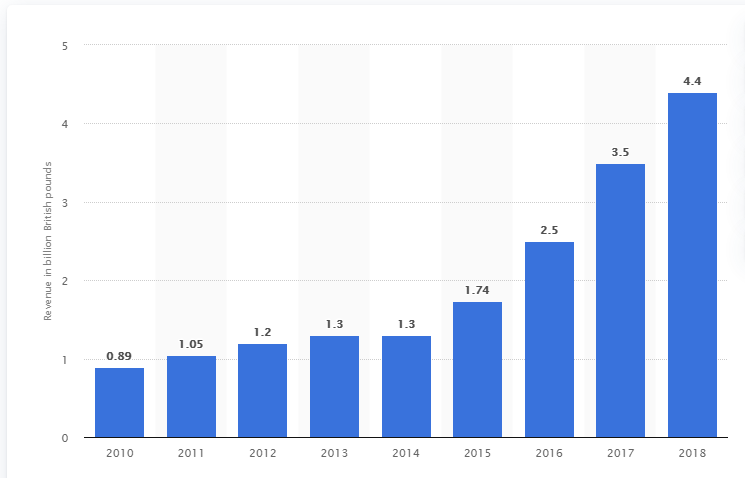
To attain the above-mentioned goals, there is an expectation that Dyson’s revenue should grow by about 25% for the next five years and the gross profit margin increase to 60% by 2025. Supporting these projections is the assumption that there will be a steady decline in the cost of sales as digital marketing techniques are adopted and technology-based solutions are used to supplement operational activities. Additionally, it is expected that the innovative capabilities integrated into the company’s products will pay off in reduced operational costs as the competitors’ products remain relatively expensive.
Moreover, the adoption of digital marketing techniques in the company’s overall plan is expected to cause a decline in marketing expenses as a percentage of the company’s sales numbers. The 60% target set as the gross profit margin is ambitious but historical data has shown that it is achievable given that this figure hit 50% in the year 2019 (Statista, 2021). Nonetheless, with the adoption of the digital marketing strategy, there is an expectation that marketing costs should not exceed 10%o the total expenditure.
Break-Even analysis
Given that Dyson’s US business is largely based on a direct export strategy where products are manufactured in the UK and sold in the US, there is an expectation that the break-even point for the business will be achieved early in its inception stage. Based on the above-mentioned operational strategy, Dyson has an unusually low overhead cost, which is about 40% of the total expenses. With the implementation of a digital marketing strategy, this percentage is likely to decline further. Table 2 below shows the break-even forecast for the business.
Table 2. Break-even Analysis
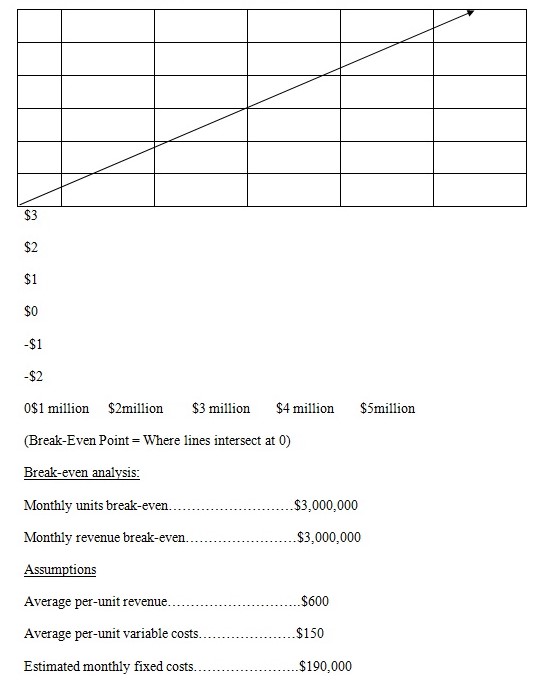
Sales Forecast
The sales forecast for the first year is expected to be $1 million and increase to $5 million in the fifth. These figures are aggressive but they are supported by the positive brand image that Dyson’s products have in the US. Most US consumers deem it a durable brand compared to all others in the market due to its high quality. The sales projections outlined above are also supported by the plan to include more partners who will be included as part of the research and development team. The goal of increasing annual revenues from the current £4.4 billion to £6 billion by 2025 is dependent on the monthly total sales numbers provided in figure 3 below.
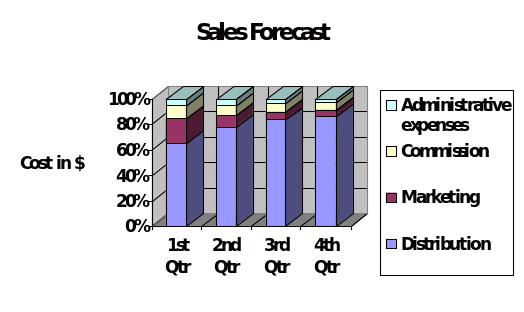
A comprehensive and tabulated result of the sales forecast is highlighted in table 3 below.
Table 3. Sales Forecast
Sales Breakdown by Model of Business
As highlighted in this report, the marketing plan will be implemented in two forms. The first one will be based on the brick and mortar business model, while the second one is premised on the online framework. The two models will be the main sources of revenue as highlighted in table 3 above.
Sales Breakdown by Segment
Most of the sales revenues for the first year of operation are expected to come from the vacuum business. This is because Dyson Company is better known in the US for its quality vacuum products. In the second year of operations, about 30% of the sales revenue is expected to come from the hairdryer business and the revenue for subsequent years is projected to come from the air purifier businesses. Therefore, revenue from the hairdryer and air purifier products is supposed to complement those from the main vacuum business.
Sales Breakdown by Region
The sales projections outlined in table 3 above are expected to come from 10 regional zones, which are described in figure 4 below as the ten regional councils. They include Western New York, Finger Lakes, Southern Tier, Central New York, Mohawk Valley, North Country, Capital Region, Mid-Hudson, New York City, and Long Island.
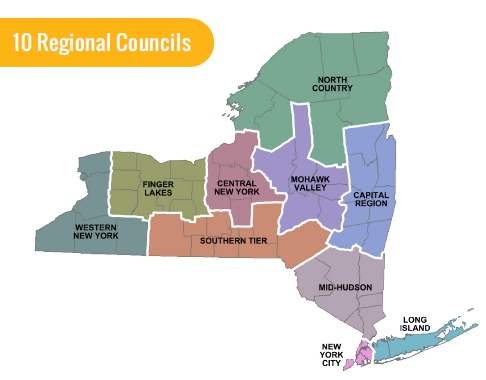
Initial sales revenues are expected to be generated from the New York City region, which is the most highly populated market. This sales region is comprised of the Bronx, Kings, New York, Queens, and Richmond.
Expense Forecast
There are four key areas of spend that will characterize the marketing operations of Dyson Company. They include administrative costs, distribution expenses, digital marketing, and commissions. Administrative expenses are expected to plateau from the second to the fifth year after setting up the distribution infrastructure in the first year.
Commissions will mainly be attributed to the brick-and-mortar business model whereby sales agents will be compensated based on their performance. The digital marketing strategy is also another key area of spend that is expected to complement this revenue stream but due to the inexpensive nature of the strategy, the sales expenditure is expected to be consistently less than 30%of the total expenses.
Expense Breakdown by Partner
As highlighted in the expense breakdown in table 3, four core areas of spend will characterize Dyson’s marketing plan: administrative, digital marketing, distribution, and commissions. Dyson’s employees will manage administrative and digital marketing operations, thereby negating the need to involve outside partners. However, their distribution and sales plans will involve partnerships with third-party actors. For the sales plan, commissions will be paid to individual entities and groups that will be part of the promotion team. Alternatively, the distribution plan will involve transportation and logistics companies that will deliver products to customers.
Expense Breakdown by Segment
The total expense breakdown is mainly linked to general market expenses as opposed to specific areas of revenue growth. This strategy is justifiable because Dyson’s brand value and reputation are more important than specific product categories, which may be modified or rendered obsolete due to innovation. Nonetheless, it is expected that the digital marketing strategy will generally reduce overall marketing expenses and eventually replace all forms of alternative marketing techniques currently being used by the company.
Expense Breakdown by Region
As highlighted in this report, the New York City region will be the focus of the marketing plan because it is highly populated. Therefore, it is projected that most of the sales expenditure will be directed to this market, at least in the first two years of operations. To recap, this market is comprised of the Bronx, Kings, New York, Queens, and Richmond.
Linking Expenses to Strategy and Tactics
There is a strategic link between the adoption of the digital marketing strategy and the expected reduction in marketing expenses. This is because online marketing is an inexpensive marketing strategy. Therefore, it is forecasted that as sales revenues increase, overall marketing expenses will decline. Additionally, there is a strategic link between the adoption of the digital marketing strategy with the desired target demographic. Stated differently, Dyson’s employees are assumed to be tech-savvy and conversant with digital methods of marketing communications and operations.
Contribution Margins
The contribution margin is expected to increase steadily within the forecasted five periods of analysis. Primarily this is because of two factors.
- The cost of marketing is expected to decline as the brand establishes itself in the new market. Furthermore, as highlighted in this document, administrative expenses are expected to stagnate from the second year of operation, and expenses for the digital marketing strategy projected to decrease over time due to their inexpensive nature.
- Once a critical mass of clients is established in New York City, word-of-mouth communication and the creation of online communities are expected to increase sales further with minimal involvement of company staff. This goal is likely to be realized from the third year of operation. Therefore, towards, the fifth year of assessment, the contribution margin is expected to peak.
Given the two factors highlighted above, the net overall contribution margin is expected to increase from 30% in the first year to 60% in the fifth year.
Controls
The success of a robust marketing plan depends on how well it is implemented. As highlighted in this document, the overall goal of this marketing plan is to improve the marketing strategy of Dyson Company and make it better to sustain growth momentum in its US business. In this section of the report, key segments of the implementation program will be highlighted.
Implementation
The implementation plan will be employed in two phases. The first one will be a monthly review of the project milestones to make sure that each aspect of the marketing plan is being carried out, as it should. The second assessment process will be based on an annual evaluation, which will seek to find out whether the yearly targets are being met, and identify strategies that could be adopted to further improve the outcomes.
Marketing Organization
The marketing plan will be spearheaded by the Dyson marketing department, which is headed by the senior brand manager. As a team, the main task of the marketing department is to work on strategy and delivery of brand new technology. The senior brand manager has two senior staff tasked with helping him to realize the above-mentioned objectives. They include the after-market project manager and assistant manager. The assistant manager will mainly be tasked with the responsibility of implementing the digital marketing strategy, while the after-market project manager will have the responsibility of overseeing the brick-and-mortar business model.
Contingency Planning
The most anticipated change in the overall marketing plan is an increase in website traffic that will mainly be buoyed by the adoption of the digital marketing strategy. Alternatively, emphasis will also be made to bolster other aspects of the digital promotion plan, including website and email marketing as supplementary techniques for supporting the overall digital marketing goals of the business. In the first year of operation, the company is expected to derive its market appeal from the positive brand reputation it enjoys in the market for being innovative and of superior quality.
References
Alaimo, C., Kallinikos, J., & Valderrama, E. (2020). Platforms as service ecosystems: Lessons from social media. Journal of Information Technology, 35(1), 25-48.
Craft Company. (2021). Dyson competitors. Web.
Dyson College of Design. (2021). An introduction to Design Engineering. Web.
Dyson-Indeed. (2020). About Dyson. Web.
General Court of the European Union. (2018). The General Court annuls the regulation on the energy labelling of vacuum cleaners. Web.
McEwen, N., & Murphy, M. C. (2021). Brexit and the union: Territorial voice, exit, and re-entry strategies in Scotland and Northern Ireland after EU exit. International Political Science Review, 6(1), 1-10.
New York State of Opportunity. (2019). Regional economic and development councils. Web.
Safa, M., Sharma, N., & Zelbst, P. (2021). Information-driven supply chain during a catastrophic event: COVID-19 pandemic. Journal of Operations and Strategic Planning, 7(2), 1-11.
Sinha, D., Bagodi, V., & Dey, D. (2020). The supply chain disruption framework post COVID-19: A system dynamics model. Foreign Trade Review, 55(4), 511-534.
Statista. (2021). Annual revenue of Dyson Ltd worldwide from 2010 to 2018. Web.
Tani, M. (2017). Multinationals in Asia: Dyson’s whirlwind of ambition centres on Asia. Web.
United States Census Bureau. (20201). New York. Web.
van Wijk, J., Zietsma, C., Dorado, S., de Bakker, F. G. A., & Martí, I. (2019). Social innovation: Integrating micro, meso, and macro level insights from institutional theory. Business & Society, 58(5), 887-918.